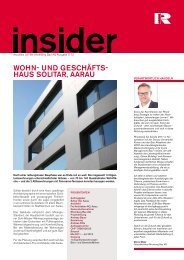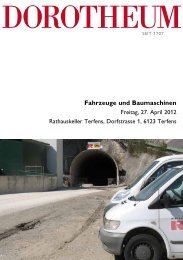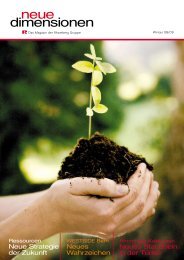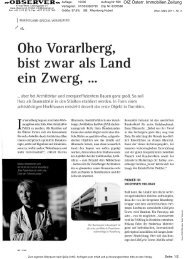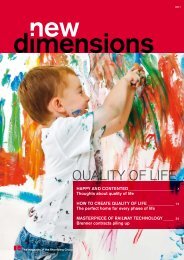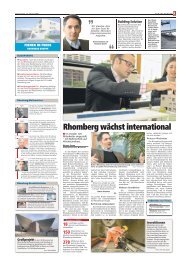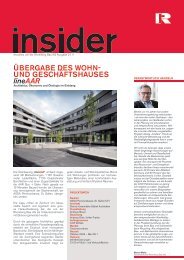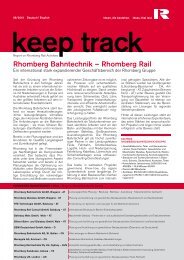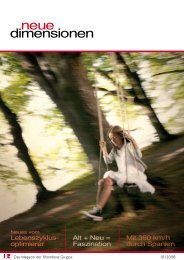ENERGY ENERGY
ENERGY ENERGY
ENERGY ENERGY
Create successful ePaper yourself
Turn your PDF publications into a flip-book with our unique Google optimized e-Paper software.
Energy abundance in a world of scarcity<br />
Gunter Pauli has initiated the concept of “The Blue Economy” to protect the eco-system<br />
Sustainability has been defined as “the<br />
ability to satisfy basic human needs<br />
with existing means”. If we apply this<br />
logic to energy, we are forced to think<br />
again about our current model. It is<br />
a fact that ever since the concept of<br />
centralised generation and distribution<br />
of electricity was established more<br />
than a hundred years ago, potential<br />
local sources of energy were only<br />
rarely tapped. If we ignore this portfolio<br />
of energy sources, we will continue to<br />
pay a high price – in the form of costs<br />
and the destruction of the environment.<br />
If, however, we change our attitude and<br />
integrate a number of local sources<br />
of energy and heat, we could turn our<br />
energy balance from one of scarcity<br />
to one of abundance – and reduce<br />
environmental pollution at the same<br />
time. Surprisingly, this could also result<br />
in lower charges.<br />
DOES GREEN <strong>ENERGY</strong><br />
REALLY COST MORE?<br />
Somehow the energy producers and<br />
distributers have managed to convince<br />
both consumers and politicians that<br />
everything that is good for our health<br />
and the environment comes at a surcharge.<br />
The management talk of “core<br />
business” and “core competence” has<br />
resulted in a situation where industry<br />
has imposed on us the effects of economies<br />
of scale: energy sources were<br />
reduced to just a few, and the charge<br />
per kilowatt hour was reduced for the<br />
producer. Today’s energy mix reflects<br />
the desire to cover basic and peak<br />
loads at predictable prices with guaranteed<br />
profit margins – any additional<br />
costs are passed on to the customer.<br />
This has led to nuclear energy, coal, oil<br />
and natural gas being selected as the<br />
main sources of energy. Renewable<br />
sources of energy were typically talked<br />
down because – so the argument goes<br />
– the sun only shines for five hours<br />
per day and the wind is unreliable. In<br />
addition, renewable energy requires<br />
backup systems and storage. This<br />
would increase the cost to be borne<br />
by the customer or require appropriate<br />
public funding, which in the end must<br />
also be borne by citizens in the form of<br />
higher taxes.<br />
QUESTIONING THE LOGIC<br />
The Blue Economy idea has two<br />
guiding principles which determine<br />
the identification of a new energy mix<br />
beyond that of green energy supply.<br />
Firstly: use what you have. And<br />
secondly: seek multiple uses. To make<br />
this proposal successful, it would be<br />
necessary to change the rules of the<br />
game. Up to now it has been largely<br />
overlooked that our current mains<br />
network supplies alternating current<br />
at 240 volts. Practically all renewable<br />
energies are generated as direct current.<br />
So additional capital is required<br />
for feeding this direct current into the<br />
mains network. If we were in a position<br />
to create local 12 volt direct current<br />
networks, many well-known but little<br />
used renewable energy sources would<br />
become commercially viable, without<br />
any major investment.<br />
The alternating current paradigm has<br />
caused us to neglect the potential of<br />
all renewable energy sources. Solar<br />
cells are only used on one side, in<br />
spite of the fact that they can generate<br />
a higher output when both sides<br />
are exposed to sunlight, which would<br />
be possible through the use of CSP<br />
technology (Concentrated Solar Power,<br />
a method of using mirrors or lenses<br />
to direct sunlight to the other side of<br />
the cells). If this energy were to be fed<br />
directly into a local 12 volt direct current<br />
network, it would be more competitive<br />
than the energy supplied via the<br />
national grid. Unfortunately however,<br />
the training of electrical engineers has<br />
been based on the alternating current<br />
logic. Properties or communities<br />
that are not connected to the mains<br />
network are seen in the same light as<br />
investment in buffer batteries. According<br />
to alternating current logic, this is<br />
just a way of unnecessarily increasing<br />
the cost to the consumer. Only very<br />
green and well-to-do citizens would<br />
be able to afford this option.<br />
Those who have opted for renewable<br />
energy production produce primarily<br />
direct current, which is then converted<br />
to alternating current and fed into the<br />
mains network, only to then be reconverted<br />
to direct current at the point<br />
of use. Do we actually realise how<br />
inefficient and expensive that is? The<br />
electronics engineers have made direct<br />
current the standard. More than 80<br />
percent of household equipment run<br />
on microelectronics current is operated<br />
with direct current. If we count the<br />
number of chargers in the household –<br />
which in effect are AC/DC converters –<br />
the degree of inefficiency we are quietly<br />
tolerating becomes very clear.<br />
REVIEWING THE ALTERNATING<br />
CURRENT STANDARD<br />
The alternating current standard was<br />
established more than one hundred<br />
years ago. Local direct current networks<br />
which are connected to local<br />
sources of electricity present a new<br />
competitive model with high efficiency.<br />
They can help to reduce the demand<br />
for energy by up to 60 percent without<br />
negative impact on performance or<br />
comfort. Local direct current networks<br />
also have a positive effect on health<br />
and safety. There is less risk of fire<br />
and electrical shock, and wiring, metal<br />
consumption and maintenance are<br />
reduced. The changeover to a local<br />
portfolio of direct current sources is<br />
just the first step. Further adaptations<br />
will be necessary, including a more<br />
intelligent utilisation of the available<br />
sources.<br />
OUR OPPORTUNITY: BETTER<br />
WATER MANAGEMENT<br />
It always comes as a surprise when we<br />
realise how little effort building designers<br />
make to exploit the laws of physics<br />
for the purpose of improving the quality<br />
of life in general, and energy efficiency<br />
in particular. A fresh look at water<br />
could change that. For example, a thermosiphon<br />
will work all year round with<br />
the hot water – predictably – rising to<br />
the top. Current technology in existing<br />
systems uses pumps, which increase<br />
both cost and energy consumption. If<br />
solar energy or simply just luminescence<br />
were used to generate electricity<br />
and heat water – using both sides<br />
of special solar modules as supplied<br />
by the Swedish innovation company<br />
Solarus AB – four to six panels would<br />
In 2010 Gunter Pauli<br />
published his book<br />
“The Blue Economy.<br />
10 years, 100 innovations,<br />
100 million jobs.”<br />
be sufficient to supply a single family<br />
home with electricity, hot water, and<br />
cooling.<br />
While this thermosiphon transports<br />
water to the top of the building, the<br />
falling water could – predictably – generate<br />
electricity and, at the same time,<br />
result in several additional benefits.<br />
For example, the water current could<br />
provide the energy to locally create<br />
ozone from the oxygen dissolved in the<br />
water, and to destroy elemental chlorine.<br />
When water is stored at the top<br />
of the building at 80 or even 90°C, it is<br />
possible to provide domestic hot water<br />
at 38 to 40°C while at the same time<br />
generating direct current using a solid<br />
state heat exchanger which utilises the<br />
differential of 40 to 50°C.<br />
RECYCLING WASTEWATER<br />
AND SOLID WASTE<br />
We can also apply the logic of “use<br />
what you have in order to gain multiple<br />
benefits” to the treatment of wastewater<br />
and solid waste. A central collection<br />
point and familiarity with biochemical<br />
reactions of black water sludge and<br />
solid organic waste make it possible to<br />
produce four times more methane gas<br />
than was previously thought possible.<br />
These waste energies – which will<br />
be available for as long as there are<br />
people – provide a steady and cheap<br />
source of methane. When one combines<br />
the smart chemistry offered by<br />
Scandinavian Biogas Chemie with the<br />
Vortex technology offered by AgroPlas<br />
of Great Britain, one can generate<br />
hydrogen for the operation of fuel cells<br />
whenever there is need for it. The only<br />
residue from this process is carbon<br />
powder, which has a commercial use.<br />
This may sound as if it is too good to<br />
be true, but it is reality.<br />
LEARNING NEW WAYS<br />
OF THINKING<br />
The biggest challenge lies in the fact<br />
that too few building designers and<br />
energy experts are trained in thinking<br />
this way. Furthermore, the few that<br />
are able to think that way may not<br />
have access to the necessary tools.<br />
The options and opportunities<br />
described here – as well as many<br />
others which can be looked up at<br />
www.blueeconomy.de – have been<br />
dismissed as either not feasible,<br />
futuristic, or at least too expensive.<br />
The time is right to progress from<br />
pure fantasy to a vision based on<br />
science so that these opportunities<br />
enter the mainstream of common<br />
knowledge. This requires us to be<br />
prepared to depart from our comfort<br />
zone, and to make it a priority to steer<br />
our economy and society at large on<br />
to the course of sustainability – using<br />
what we have.<br />
Gunter Pauli<br />
6 NEW DIMENSIONS | <strong>ENERGY</strong><br />
<strong>ENERGY</strong> | NEW DIMENSIONS 7



